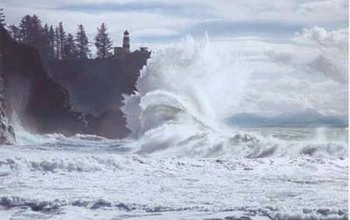Hola amigos: A VUELO DE UN QUINDE EL BLOG., Haciendo una parodia En todo el planeta, cada día, los océanos envían plumas de mar aerosol en la atmósfera. Más allá de la poesía de la que se estrellan las olas del mar, este spray salada y rica en carbono también tiene un efecto dramático en la formación de nubes y la duración.
More information............
Aerosols have impact on cloud composition, duration Credit and Larger Version |
All over the planet, every day, oceans send plumes of sea spray into the atmosphere. Beyond the poetry of crashing ocean waves, this salt- and carbon-rich spray also has a dramatic effect on cloud formation and duration.
In a new paper published this week in the journal Proceedings of the National Academy of Sciences, Colorado State University atmospheric scientist Paul DeMott finds that sea spray is a unique, underappreciated source of what are called ice nucleating particles. These microscopic bits make their way into clouds and initiate the formation of ice, affecting the clouds' composition.
"The presence of these particles is critically important for precipitation and the lifetime of clouds, and consequently, for their radiative properties," DeMott said.
Added Nick Anderson, program director in the National Science Foundation (NSF) Division of Atmospheric and Geospace Sciences, which funded the research: "The development of clouds and precipitation is a core issue for understanding weather and climate processes. By studying ice nuclei, which can be considered a building block for clouds, these researchers will help piece together the puzzle of how clouds and precipitation form, especially over remote oceanic regions."
Clouds cover 60 percent of the Earth's surface at any given time. With their ability to reflect solar energy and absorb terrestrial radiation, clouds have dramatic effects on climate.
That ability is greatly influenced by the number, size and type of droplets and ice particles they contain. These cloud particles come from aerosols -- particles suspended in air -- from land and ocean surfaces.
From desert dust to fossil fuels, aerosols that affect clouds are everywhere.
The study has confirmed that ice nucleating particles from oceans are distinct -- both in their abundance and ice-making properties -- from land-sourced particles. Hence, their influence on the liquid-to-ice phase structure of clouds, and the clouds' radiative characteristics, can differ over vast swaths of Earth.
The laboratory portion of the study was conducted with other researchers at the NSF-supported Center for Aerosol Impacts on Climate and the Environment (CAICE), at which DeMott is a senior scientist.
Based at the University of California-San Diego, CAICE has laboratory wave flumes that simulate how ocean waves send sea spray aerosols into the air.
Researchers can study the biological and chemical makeup of these particles, as well as the transformations they undergo, and use special instruments to see how they influence cloud formation. DeMott and colleagues compared these data to other measurements made over oceans.
The study offers one explanation for why global climate models have consistently underestimated reflected, short-wave solar radiation in regions dominated by oceans, particularly in the southern hemisphere.
"Our paper gives a clearer picture of the behavior of major classes of atmospheric aerosols in clouds," DeMott said.
-NSF-
Media Contacts Cheryl Dybas, NSF, (703) 292-7734,
cdybas@nsf.gov
Anne Manning, Colorado State University, (970) 491-7099,
Anne Manning, Colorado State University, (970) 491-7099,
Related WebsitesNSF Award: Laboratory and Surface-based Studies of Atmospherically-relevant Ice Nucleating Particle Sources, Concentrations and Compositions:
http://www.nsf.gov/awardsearch/showAward?AWD_ID=1358495&HistoricalAwards=false
Science Nation: Sea Spray -- Complex chemistry with big effects on climate:
Science Nation: Sea Spray -- Complex chemistry with big effects on climate:
http://1.usa.gov/1IdPDCi
NSF Award: CCI Center for Aerosol Impacts on Climate and the Environment:
NSF Award: CCI Center for Aerosol Impacts on Climate and the Environment:
The National Science Foundation (NSF) is an independent federal agency that supports fundamental research and education across all fields of science and engineering. In fiscal year (FY) 2015, its budget is $7.3 billion. NSF funds reach all 50 states through grants to nearly 2,000 colleges, universities and other institutions. Each year, NSF receives about 48,000 competitive proposals for funding, and makes about 11,000 new funding awards. NSF also awards about $626 million in professional and service contracts yearly.
Useful NSF Web Sites:
NSF Home Page:
NSF Home Page:
http://www.nsf.gov
NSF News:
NSF News:
http://www.nsf.gov/news/
For the News Media:
For the News Media:
http://www.nsf.gov/news/newsroom.jsp
Science and Engineering Statistics:
Science and Engineering Statistics:
http://www.nsf.gov/statistics/
Awards Searches:
http://www.nsf.gov/awardsearch/Awards Searches:

Ice nucleating particles from sea spray make their way into clouds, affecting clouds' longevity.
Credit and Larger Version

Clouds cover 60 percent of Earth's surface at any given time.
Credit and Larger Version

Clouds' ability to reflect solar energy and absorb radiation affect Earth's climate.
Credit and Larger Version

Earth's oceans and atmosphere are inextricably linked in how long clouds last.
Credit and Larger Version

Ice nucleating particles from oceans are distinct from those on land, scientists have found.
Credit and Larger Version
The National Science Foundation (NSF)
Guillermo Gonzalo Sánchez Achutegui
ayabaca@gmail.com
ayabaca@hotmail.com
ayabaca@yahoo.com
Inscríbete en el Foro del blog y participa : A Vuelo De Un Quinde - El Foro!

No hay comentarios:
Publicar un comentario